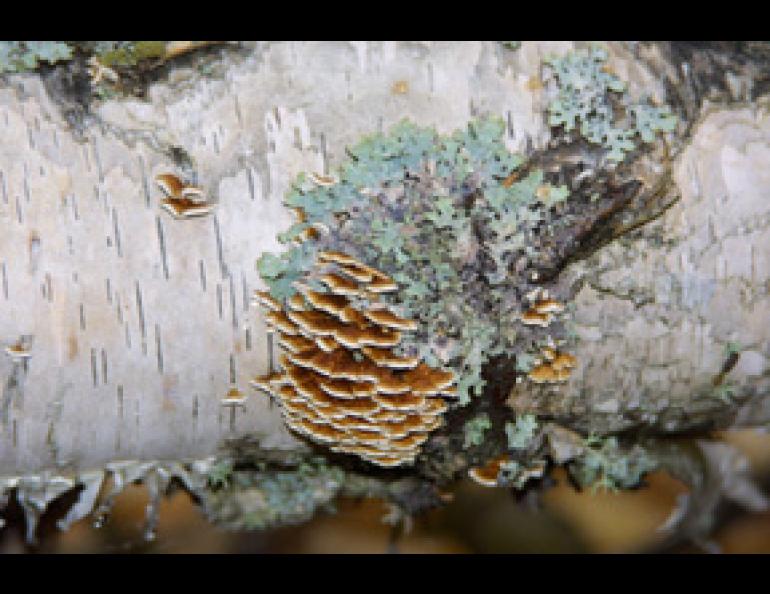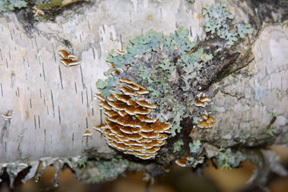
Mysterious Kingdom Covers Alaska from Tundra to Toe
Gary Laursen is the sole professional explorer of a vast kingdom in Alaska. Fungi, the subjects in this kingdom, live in the woods, in refrigerators, on rocks, and between our toes. Without them, the natural world would cease to function.
Laursen is the state’s only working mycologist (a person who studies fungi) and a professor at the University of Alaska Fairbanks Department of Biology and Wildlife. He spends his summers traveling across Alaska from the North Slope to Southeast, searching for Hobbit worlds of fungi that pop up in late summer and autumn before disappearing back into the soil. His goal is to inventory the fungi of Alaska, and to determine the roles fungi play in the ecology of different areas of the state.
To classify living things, scientists have created five kingdoms—plants, animals, protists (single-celled creatures including plankton), monera (bacteria), and fungi. Unlike the plant or animal kingdoms, in which scientists have identified and studied most species, the fungi kingdom is a frontier.
No one has yet detailed all the species of fungi that live in Alaska. Several thousand species of fungi exist, but scientists have only described about 50,000. Laursen describes each scouting trip into new territory, such as the Great Kobuk Sand Dunes, as a northern safari.
“The myriad life forms continue to blow me away,” Laursen said.
The fungi kingdom includes mushrooms, which are the fruiting bodies of a more complex underground organism, yeast used to make bread and beer, penicillin and other drugs, molds that grow on leftovers, and parasitic fungi of the human body, such as athlete’s foot fungus. All fungi digest food outside their own bodies by secreting acids and enzymes that break down organic material. Lacking stomachs, fungi absorb the simple molecules of food through their cell walls.
The fungi that produce mushrooms are some of the most important in Alaska. Without them, the boreal forest would not exist. Beneath the soil, fungi cling to tree roots in a symbiotic relationship that results in mycorrhizae—roots coated with hairy fungi that help trees and other plants absorb minerals. The tree, with its ability to produce carbohydrates from sunlight and carbon dioxide, provides food for the fungus. Conks, woody growths that look like little shelves, also feed on dead trees, speeding the trees’ transformation into soil. Without fungi, the boreal forest would not grow or decay.
Squirrels, both red and flying, help fungi renew the forest. In fall, squirrels gather mushrooms and carry them to their nests. Both varieties of squirrels eat mushrooms all winter long. Mushrooms contain spores, which are like seeds in plants. Squirrels carry the spores for awhile and them deposit them elsewhere as they defecate. A rust fungus also provides a home for flying squirrels by creating witches broom—dense tangles of spruce branches that appear on trees affected by the fungus.
Fungi’s affinity for teaming up has produced one of the neatest organisms in Alaska—the lichen. Lichen carpets the slopes of many alpine areas in Alaska, clinging to rocks and tundra like dry and scaly starfish. Favorite foods of caribou, which can eat up to 15 pounds in a day, lichens are the result of a partnership between a fungus and an alga or cyanobacteria. The fungus has the dominant role, influencing the body shape of the lichen and its toughness or flexibility. The alga or cyanobacteria contribute the green pigment chlorophyll, enabling lichen to process the sun’s energy for photosynthesis. This enables lichen to be a free-living life form, sometimes clinging to wood or rocks, but often anchoring themselves to nothing.
Laursen enjoys studying fungi because it takes him to great places—recently to Toolik Lake, Prince of Wales Island, the Russian Far East, Sitka, and the country north of Fairbanks. He said learning more about the mysterious kingdom of fungi makes Alaska an even more interesting place.
“The forest just comes alive,” he said.





